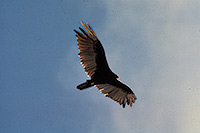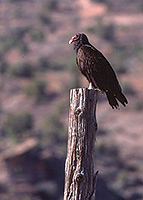 You see them early in the morning; wings stretched outwards like yoga masters, a curtain of feathers spread wide absorbing the morning sun. Or maybe it’s mid-morning or mid-day when the desert heat rises creating thermals, channels of air the birds use to spiral upwards. They fly effortlessly; wings held at a slight angle, body’s rocking side to side as they ride a cushion of warm air. Of course, “they” are turkey vultures, the scavengers of the Southwest, cleansers of carcasses, purifiers of the putrid.
You see them early in the morning; wings stretched outwards like yoga masters, a curtain of feathers spread wide absorbing the morning sun. Or maybe it’s mid-morning or mid-day when the desert heat rises creating thermals, channels of air the birds use to spiral upwards. They fly effortlessly; wings held at a slight angle, body’s rocking side to side as they ride a cushion of warm air. Of course, “they” are turkey vultures, the scavengers of the Southwest, cleansers of carcasses, purifiers of the putrid.
Classified as birds of prey, turkey vultures rarely kill their own food. Instead, they hunt the dead and dying. A morbid endeavor? No, more a necessary evil. They play an important role, on part with the lowest level producers and highest level consumers. They are the cart-masters in a Monte Python skit crying, “Bring out your dead!”
 Named after their turkey-red head skin and dark coloring, turkey vultures arrive in the Southwest in early spring and spend the summer months raising young. Locating a vulture nest is a challenge, for they use alcoves or ledges on high cliff faces or sizeable snags away from disturbance. I’ve never seen one of their nests, but have to admit I’ve also never looked.
Named after their turkey-red head skin and dark coloring, turkey vultures arrive in the Southwest in early spring and spend the summer months raising young. Locating a vulture nest is a challenge, for they use alcoves or ledges on high cliff faces or sizeable snags away from disturbance. I’ve never seen one of their nests, but have to admit I’ve also never looked.
The vultures don’t go in for big nests, laying 1-3 eggs that might take a month or more to hatch. Add in another 2-3 months in the nest and their juveniles are ready to fledge.
One can tell juveniles from the adults by the light coloration of the juvenile’s head skin versus the reddish skin of the adults. This skin color can change in hue depending upon the vultures’ response to emotional conditions. Both adults and juveniles share the same plumage: dark wings and back and two-toned underwings with black on the leading edge and white on the trailing edge of the wings. In flight, this is a good field mark, differentiating the vultures from the darker undersides of golden and bald eagles.
Though cartoons often depict a solitary vulture or “buzzard”, as they are sometimes called, sitting upright in a cactus waiting for their prey to perish, these are social birds. Relying upon others to signal a meal, vultures are often alerted to a carcass by a gathering of ravens or a flight of magpies towards some unfortunate road kill. Of course, vultures also rely on themselves, using their keen eyesight and excellent sense of smell to locate meals. Their sense of smell is legendary.
 Not all see the vulture’s role in a negative light. Tibetan Buddhists view vultures and other animals as integral parts of “sky burials,” where the birds carry the soul of the dead to the heavens.
Not all see the vulture’s role in a negative light. Tibetan Buddhists view vultures and other animals as integral parts of “sky burials,” where the birds carry the soul of the dead to the heavens.
Vultures also play another role, albeit an unwilling one, as heralds of lead poisoning. Able to dissolve lead fragments embedded in a carcass, toxic lead levels build up within their blood streams. This has been more a problem for the California condor, a relative of the turkey vulture, whose population recovery is a delicate balance. The banning of lead shot or bullets has been implemented in many locations; steel or copper shot and bullets are replacing the toxic spent lead.
But on a clear morning, with the vultures communally roosting in some large cottonwood, the idea of their demise is far away. The Grim Reaper is their partner and if the old saying about death and taxes continues to hold true, these birds have job security to last the ages.

 You see them early in the morning; wings stretched outwards like yoga masters, a curtain of feathers spread wide absorbing the morning sun. Or maybe it’s mid-morning or mid-day when the desert heat rises creating thermals, channels of air the birds use to spiral upwards. They fly effortlessly; wings held at a slight angle, body’s rocking side to side as they ride a cushion of warm air. Of course, “they” are turkey vultures, the scavengers of the Southwest, cleansers of carcasses, purifiers of the putrid.
You see them early in the morning; wings stretched outwards like yoga masters, a curtain of feathers spread wide absorbing the morning sun. Or maybe it’s mid-morning or mid-day when the desert heat rises creating thermals, channels of air the birds use to spiral upwards. They fly effortlessly; wings held at a slight angle, body’s rocking side to side as they ride a cushion of warm air. Of course, “they” are turkey vultures, the scavengers of the Southwest, cleansers of carcasses, purifiers of the putrid. Named after their turkey-red head skin and dark coloring, turkey vultures arrive in the Southwest in early spring and spend the summer months raising young. Locating a vulture nest is a challenge, for they use alcoves or ledges on high cliff faces or sizeable snags away from disturbance. I’ve never seen one of their nests, but have to admit I’ve also never looked.
Named after their turkey-red head skin and dark coloring, turkey vultures arrive in the Southwest in early spring and spend the summer months raising young. Locating a vulture nest is a challenge, for they use alcoves or ledges on high cliff faces or sizeable snags away from disturbance. I’ve never seen one of their nests, but have to admit I’ve also never looked.  Not all see the vulture’s role in a negative light. Tibetan Buddhists view vultures and other animals as integral parts of “sky burials,” where the birds carry the soul of the dead to the heavens.
Not all see the vulture’s role in a negative light. Tibetan Buddhists view vultures and other animals as integral parts of “sky burials,” where the birds carry the soul of the dead to the heavens.